
Argyresthia pruniella, the cherry fruit moth or cherry blossom tineid, is a moth from the family Yponomeutidae, the ermine moths.

Scythropia crataegella, the hawthorn moth, is a species of moth in the monotypic genus Scythropia. It is found in western Eurasia.

Argyresthia albistria is a moth of the family Yponomeutidae. It is found in most of Europe.
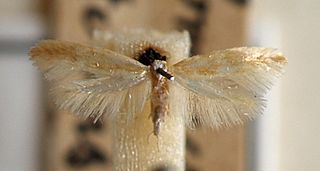
Argyresthia aurulentella is a moth of the family Yponomeutidae. It is found in Northern Europe, Central Europe, western Russia and Macedonia.
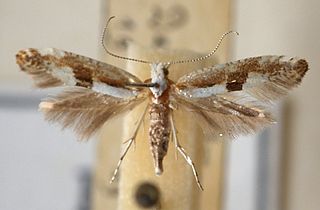
Argyresthia bonnetella is a moth of the family Yponomeutidae. It is found in Europe. The wingspan is 9–11 mm. The head is white. Forewings are shining ochreous-whitish, usually strigulated and sometimes discally suffused with ferruginous brown; a suffused ferruginous -brown median longitudinal streak from base to before middle; a curved dark ferruginous- brown fascia from middle of dorsum to 4/5 of costa, sometimes obsolete except on dorsum. Hindwings are grey. The larva is yellow-green; head and plate of 2 brown.
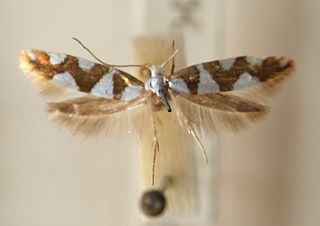
Argyresthia brockeella is a moth of the family Yponomeutidae. It is found in Europe, east Siberia and Japan. The wingspan is 9–12 mm. The head and thorax are white. Forewings are deep coppery-golden; a spot on base of dorsum, a fascia at 1/3, three posterior semioval costal spots and a larger tornal spot shining white; sometimes the fascia is connected with adjacent costal and dorsal spots. Hindwings are grey. The larva is pinkish-brown; head brown; plate of 2 partly blackish-edged.

Argyresthia curvella is a species of ermine moth. It belongs to subfamily Argyresthiinae, which is sometimes elevated to full family rank in the superfamily Yponomeutoidea. It is commonly called apple blossom tineid, reflecting the fact that it was originally believed to be a tineid moth.
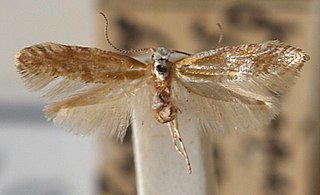
Argyresthia dilectella is a moth of the family Yponomeutidae. It is found in Northern Europe and Central Europe.

Argyresthia goedartella, the bronze alder moth, is a species of moth of the family Argyresthiidae.

Argyresthia semitestacella is a moth of the family Yponomeutidae. It is found in Europe.

Argyresthia pygmaeella is a moth of the family Yponomeutidae. The species was first described by Michael Denis and Ignaz Schiffermüller in 1775 from a specimen found near Vienna, Austria
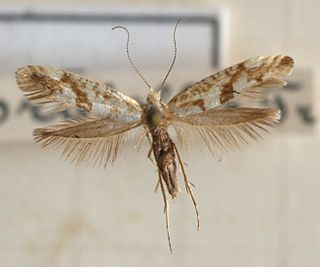
Argyresthia sorbiella is a moth of the family Yponomeutidae. It is found in Northern Europe and Central Europe.

Argyresthia spinosella is a moth of the family Yponomeutidae. It is found in Europe and Anatolia.

Argyresthia laevigatella is a moth of the family Yponomeutidae. It is found in Europe and Japan.

Argyresthia conjugella, the apple fruit moth, is a moth of the family Yponomeutidae. It is found in Europe, Siberia, Central Asia, Japan, and North America.
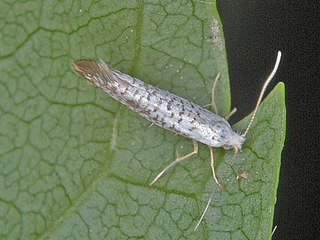
Argyresthia retinella is a species of moth of the family Yponomeutidae.
Argyresthia arceuthina is a moth of the family Yponomeutidae. It is found in Europe.

Argyresthia glaucinella is a moth of the family Yponomeutidae. It is found in Europe.
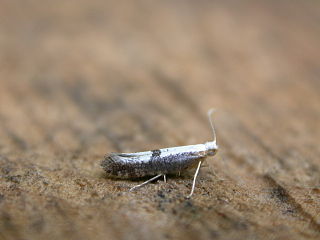
Argyresthia semifusca is a moth of the family Yponomeutidae. It is found in Europe.
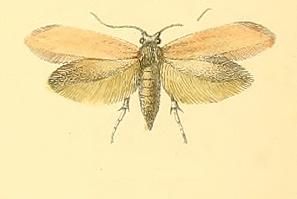
Argyresthia bergiella is a moth of the family Yponomeutidae. It is found in most of Europe, except Ireland, Great Britain, Belgium, the Iberian Peninsula and most of the Balkan Peninsula.


















